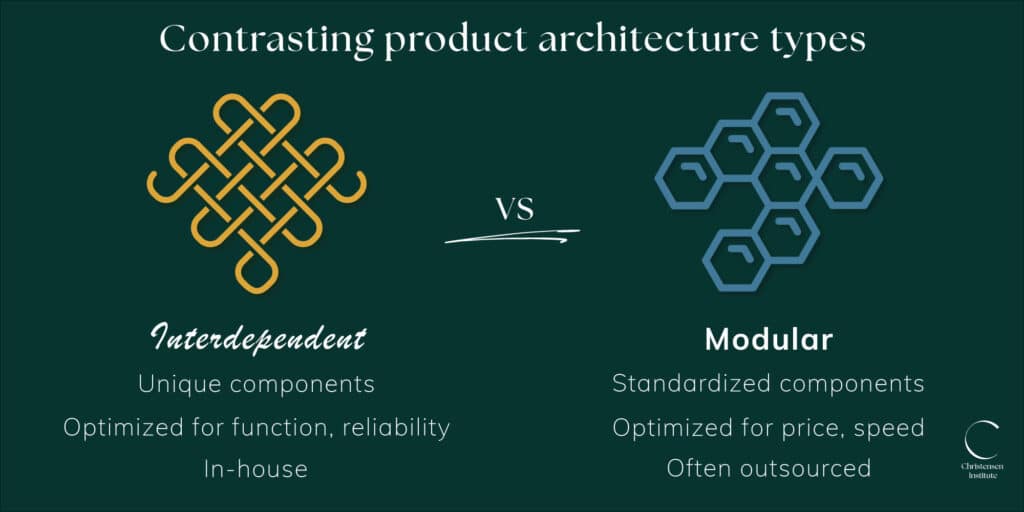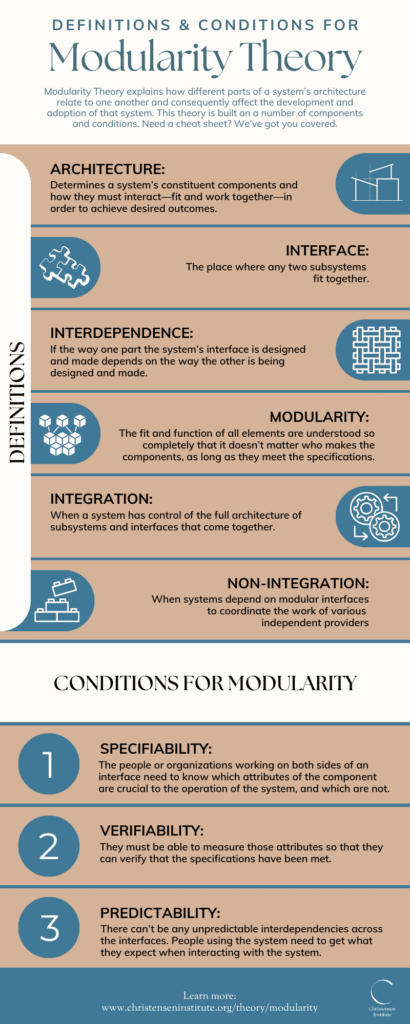Modularity Theory
The theory that spurs performance and explains adoption of a product or service within a market.

Definition
Modularity Theory (or the Theory of Interdependence and Modularity) explains how different parts of a system’s architecture relate to one another and consequently affect the development and adoption of that system.
According to the theory, a system’s architecture determines its components and systems and defines how they must interact—fit and work together—in order to achieve desired outcomes.
The place where any two subsystems fit together is called an interface. A system’s architecture is interdependent at an interface if one part can’t be created independently of the other. In other words, the way one is designed and made depends on the way the other is designed and made. Unpredictable interdependencies require the same person, team, or organization to simultaneously develop both components for the overall system to work.
In contrast, a modular interface is one in which there are no unpredictable interdependencies between subsystems, people, teams, or organizations. Modular components and subsystems fit and work together in well-understood and highly-defined ways. A modular system architecture specifies the fit and function of all elements so completely that it doesn’t matter who makes the components or subsystems, as long as they meet specifications. In other words, to the extent that interfaces are specifiable, verifiable, and predictable, they are modular in nature. Systems that rely on modular interfaces allow people in separate teams or organizations to do their work with little to no effort spent on coordination.

Unique Insight
The implementation of either modularity or interdependence does not determine whether a product is adopted, but predicts how quickly adoption will occur.
Explainer
What type of system architecture should you use to equip your business model? Whether it’s modular or interdependent, which one you choose as you enter the market predicts how quickly adoption of your product or service will occur. Check out our helpful video.
Case Studies
Helpful Tools
Infographic: Definitions & conditions?
Modularity Theory explains how different parts of a system’s architecture relate to one another and consequently affect the development and adoption of that system. This theory is built on a number of components and conditions. Need a cheat sheet? We’ve got you covered. Click the image to download and check out our resource library for additional content.
Definitions:
- Architecture: Determines a system’s constituent components and how they must interact—fit and work together—in order to achieve desired outcomes.
- Interface: The place where any two subsystems fit together.
- Interdependence: If the way one part the system’s interface is designed and made depends on the way the other is being designed and made.
- Modularity: The fit and function of all elements are understood so completely that it doesn’t matter who makes the components, as long as they meet the specifications.
- Integration: When a system has control of the full architecture of subsystems and interfaces that come together.
- Non-integration: When systems depend on modular interfaces to coordinate the work of various independent providers
Conditions for Modularity
- Specifiability: The people or organizations working on both sides of an interface need to know which attributes of the component are crucial to the operation of the system, and which are not.
- Verifiability: They must be able to measure those attributes so that they can verify that the specifications have been met.
- Predictability: There can’t be any unpredictable interdependencies across the interfaces. People using the system need to get what they expect when interacting with the system.
At the Clayton Christensen Institute, we’re using Modularity Theory to:

Develop student-centered teaching competencies
Most K–12 educators today don’t have the skill sets necessary to run student-centered schools. This report helps dismantle that barrier by identifying specific student-centered competencies educators can stack to create customized teaching micro-credentials.

Evaluate the growth of learning ecosystems
What if instead of formal education happening through schools, students could stack together various learning experiences from across a learning ecosystem? Integrated and non-integrated systems each have particular advantages and disadvantages when it comes to serving students. Understanding the trade-offs with each approach can help us better understand who learning ecosystems would be best suited to serve and the runway they would need in order to become viable alternatives to conventional education.

Imagine better systems of support for postsecondary alternative credentials and credit transfers
An era of increasing data interoperability,new postsecondary entrants are changing the fundamental architecture that connects higher ed students to institutions in the workforce. As a result, the very categories and boundaries in place for transfers, as well as work and learning, are being challenged.






